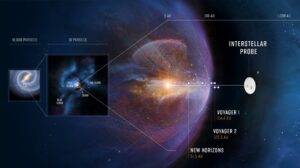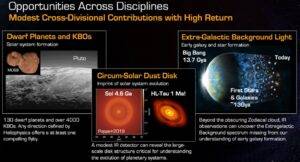Space and its vast exteriors have always been a matter of mystery. For decades, scientists have continued to find out what’s beyond the things visible to the human eye. It started with Pioneer 10 and was succeeded by Voyager 1 and Voyager 2. The main focus has been shifted to uncovering the Sun’s neighborhood, also termed the heliosphere, over a specified and planned project, the Interstellar Probe mission.

Research specialists from the Johns Hopkins University Applied Physics Laboratory did come up with a proposal for the Interstellar Probe mission at the meeting of the American Geophysical Union in Louisiana, New Orleans, 2021. The mission aims to discover what is beyond the protective bubble of the Sun, known as the heliosphere, and if there are more interesting locations to vouch upon.
Interstellar Probe mission and the endless opportunities to discover the unknown
The Interstellar Probe mission is the boldest move that aerospace scientists have thought of so far. The mission will make it easy for the human race to find out what lies in the space between us and our neighbors (the stars).
It is evident that the Sun is one among the billion other stars present in the galaxy. Using its dynamic solar wind, the Sun does uphold and sustains an enormous magnetic bubble for our solar system to continue and exist. This bubble is the heliosphere.
However, the unique mechanism that makes it possible for our heliosphere’s boundary to sustain so peacefully also has drawbacks. What lies beyond the wall is still unknown. That way, the human race continues to remain in the dark about the evolutionary journey of the galaxy this far from the days of existence.

Coming to the mission and goal of the Interstellar Probe, it will try and move beyond the heliospheric wall. Once out into the interstellar medium, the probe will continue to share information in the form of snapshots. That will include the present status of the heliosphere and the surrounding area. Ultimately for the first time, humans will be able to understand how our home looks from the outside and where it is heading.
The futuristic concept is a NASA-undertaken project and has been carried forward by the Johns Hopkins University APL. A team of 400 engineers and scientists across several disciplines and parts of the globe have come together. The entire life span of the mission has been decided at 50 years, and there are plans to start off by 2030.
The mystery of the unknown
Let’s have a look at the various facts which makes the interstellar Probe mission all the more essential as of now:
- The actual shape of the heliosphere is an underlying mystery so far. Interpretations and images of the heliosphere from the inside as per various energy ranges do contradict each other.
- Models made based on information from global physics are not in alignment.
- So far, the area beyond the heliosphere is unknown. Our little bit of understanding so far is based on the measurements from the inside. There are certain components of outer space like the neutral gas and plasma, ionization, composition, magnetic field, dust, composition, and inhomogeneities scale that humankind does not have an idea of.
- And the Voyagers’ expedition so far has only been possible to cover beyond 30AU of the heliosphere. But that area is also under the influence of the heliospheric effect.
- Understanding the area beyond the heliosphere, also known as the LISM (local interstellar medium), is essential to unravel the neighborhood of the Sun and its impact.
The interstellar Probe mission will offer an effective overview of the magnificent role of the Sun and whether it plans to enter into a fully new region anytime soon.
Interstellar Probe mission and NASA so far
The Interstellar Probe Science and Technology Definition Team of NASA did come up with a proposition in the Spring of 1999. The team made clear that there will be a 150 kg spacecraft to measure the accurate expansion of interstellar and heliospheric plasma, energetic particles, fields, dust, and neutral gas. Also, the probe will be able to cover a distance of 200-400 AU based on solar-sail propulsion technology.
The Interstellar Probe mission goals and payloads are quite exclusive and aim to get a comprehensive overview of our galaxy from outer space. As of now, there are two aircraft from NASA, Voyager 1 and 2, that have entered interstellar space. And the “new horizon” aircraft that became the first spacecraft to go near Pluto in 2015 still revolves around the Sun, informing us with the latest update. This particular is also will enter interstellar space by the 2040s.



